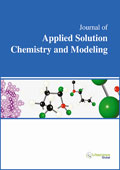jascm
Editor’s Choice : Refractive Properties of Binary Mixtures Formed by an Isomer of Chlorobutane and Butyl Ethyl Ether
|
|
Abstract: Refractive indices of the binary mixtures containing an isomer of chlorobutane (1-chlorobutane, 2-chlorobutane, 2-methyl-1-chloropropane, or 2-methyl-2-chloropropane) and butyl ethyl ether have been measured at seven temperatures from T = 283.15 to 313.15 K From these data refractive index deviations were calculated and correlated with a Redlich-Kister polynomial expansion. The refractive index deviations were found positive. Finally, from these refractive indices both densities and surface tensions of the studied systems were predicted and compared with previously reported values. Keywords: Butyl ethyl ether, Isomeric chlorobutane, Predicted properties, Refractive index.Download Full Article |
Editor’s Choice : Solubility Prediction of Paracetamol in N-Methyl-2-pyrrolidone + Ethanol + Water Mixtures at 25 °C
|
|
Abstract: The solubility of paracetamol in N-Methyl-2-pyrrolidone (NMP) + ethanol and NMP + ethanol + water solvent mixtures at 25 °C was determined using the shake flask method. The generated data extended the solubility database of pharmaceuticals and also was used to assess the solubility prediction capability of the Jouyban-Acree model in NMP + ethanol + water mixtures. The accuracy of the predicted solubilities was evaluated by the mean percentage deviation (MPD) between the predicted and experimental solubilities. The MPD of the Jouyban-Acree model for predicting the solubility of paracetamol in NMP + ethanol + water mixtures at 25 °C was 14.6 %. Keywords: Paracetamol, binary solvents, ternary solvents, solubility prediction, pharmaceutical cosolvents.Download Full Article |
Editor’s Choice : Anisotropic Properties of Mesogenic Surfactants with Ionic Liquid Core
|
|
Abstract: Ionic mesogens (HI-n), constructed from imidazolium-functionalized azobenzenes with differential flexible spacers and a nitro polar terminal group, were synthesized. Their potential thermotropic liquid crystal properties were investigated bypolarizing optical microscopy (POM), differential scanning calorimetry (DSC) and temperature variable X-ray diffraction measurements. HI-n exhibited a smectic A fluid (SmA) phase by anisotropy through interactions between azobenzene units and ionic interactions. This SmA formation was observed by POM and DSC. In the SmA phase, focal conic fan textures were observed by POM under the crossed-Nicols. The perpendicular structure (homeotropic alignment) formed spontaneously in the SmA phase through physical adsorption of imidazolium ionic units upon a glass plate. In the SmA phase, HI-n exhibited the X-ray diffraction patterns consisting of sharp inner reflections, corresponding to the layer distance, and a broad outer reflection exhibiting a short range order within the smectic layer. It is expected that the SmA layer consists of the hydrophilic and hydrophobic sublayers. The hydrophilic sublayer was formed by an ionic aggregation of imidazolium and iodide ions. On the other hand, the hydrophobic sublayer was obtained by segregation from the hydrophilic sublayer. It can be considered that HI-n are an anisotropic ionic liquid because the SmA state has a fluidity such as an ionic liquid. The ionic material shows the strong temperature dependence of an ionic interaction. The ionic interactions in the liquid crystal phase became weak gradually with increasing temperature, and the fluidity of the liquid crystal phase increase. HI-n dissolved in water. The HI-n water solution revealed a lyotropic smectic A anisotropic fluid. Keywords: Anisotropic Fluid, Ionic Liquid Core, Ionic Liquid Crystal, Thermal Property, X-ray diffraction.Download Full Article |
Editor’s Choice : Separation and Recovery of SiC Particles Discharged from Silicon Wafer Production Process
|
|
Abstract: In the slicing process of silicon wafer from silicon single crystal, it has been the general way to cut silicon by wire saws with the lubricant mixture of silicon carbide, as SiC, particles and wrapping oil. After slicing the silicon single crystal, the waste liquor containing SiC and silicon powders is discharged from the process. The particle sizes of SiC and Si are about 10μm and 1μm, respectively and the weight ratio is about 9:1. The particles discharged from slicing waste liquor become the mixture of SiC and SiO2, when the waste liquor is burned after treating the lubricant oil by a filter press. In terms of the minimization of wastes and environment, it is preferable to separate and recover the valuable SiC from SiO2. In order to solve the problem mentioned above, flotation method can be applied to accomplish the separation of SiC from SiO2. The cationic surfactants of dodecyl-tri-methyl-ammonium chloride (abbreviated as DTMAC hereafter) and tri-methyl-octyl-ammonium chloride (abbreviated as TMOAC hereafter) were used in this study. The adsorption amount of surfactants on SiC and SiO2 particles was measured. The flotation behaviors of SiC and SiO2 were investigated by changing pH, gas flow rate and flotation time in the presence of DTMAC. The purity and yield of SiC were also discussed in the flotation process comprising of roughing, cleaning and scavenging steps. A series of flotation process for SiC gave the purity and yield of 99.7% and 96.7%, respectively. Keywords: Flotation, SiC, SiO2, silicon wafer slicing waste, TMOAC, DTMAC.Download Full Article |






















